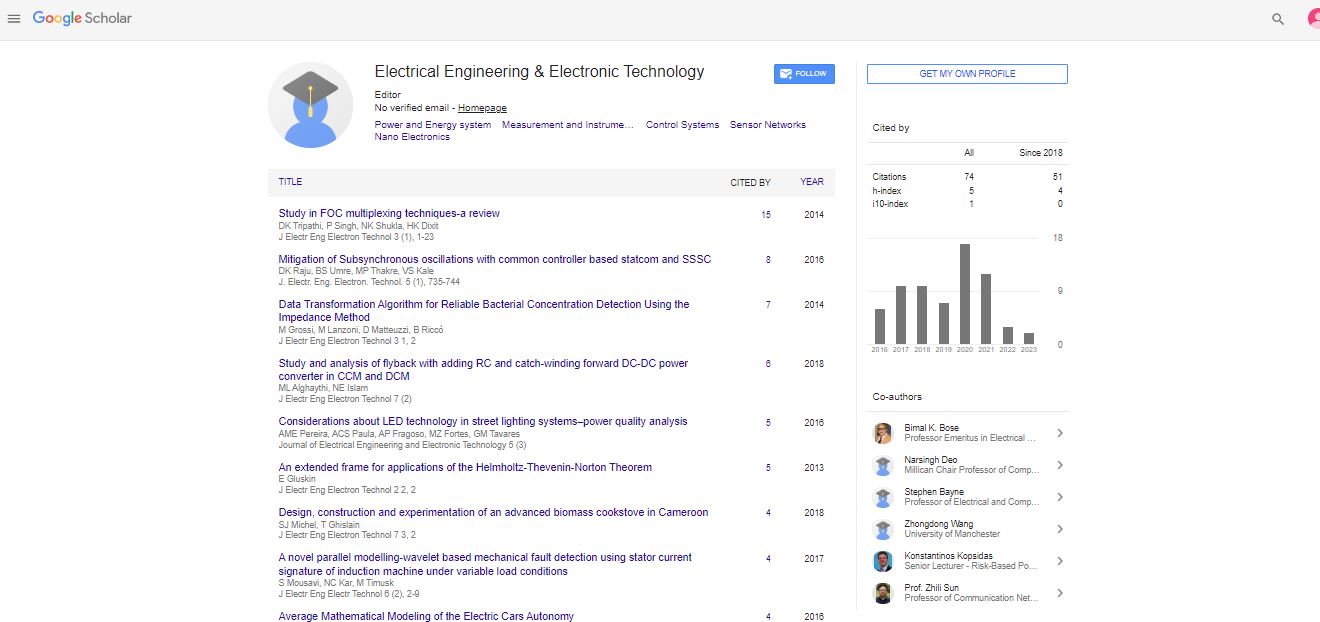Commentary, J Electr Eng Electron Technol Vol: 13 Issue: 4
Innovations in Energy Transmission and Distribution Technologies
Bang Shiyong*
1Department of Electrical Engineering, Tsinghua University, Beijing 100084, China
*Corresponding Author: Bang Shiyong,
Department of Electrical Engineering,
Tsinghua University, Beijing 100084, China
E-mail: shyiongb@cn.com
Received date: 21 June, 2024, Manuscript No. JEEET-24-143464;
Editor assigned date: 24 June, 2024, Pre QC No. JEEET-24-143464 (PQ);
Reviewed date: 8 July, 2024, QC No. JEEET-24-143464;
Revised date: 15 July, 2024, Manuscript No. JEEET-24-143464 (R);
Published date: 22 July, 2024, DOI: 0.4172/2325-9838.1000985
Citation: Shiyong B (2024) Innovations in Energy Transmission and Distribution Technologies. J Electr Eng Electron Technol 13:4.
Description
Energy transmission and distribution are important components of modern power systems, ensuring that electricity generated at power plants reaches homes, businesses and industries efficiently and reliably. As the demand for clean and sustainable energy grows, so does the need for innovations in transmission and distribution technologies. This article explores recent advancements that are shaping the future of energy infrastructure, focusing on improving efficiency, reliability and sustainability.
High-Voltage Direct Current (HVDC) systems
High-Voltage Direct Current (HVDC) technology has emerged as a significant innovation in energy transmission. Unlike traditional Alternating Current (AC) systems, HVDC allows for the transmission of electricity over long distances with lower energy losses. Reduced Losses HVDC systems experience lower transmission losses compared to AC systems, especially over long distances. This is due to the absence of reactive power and lower line losses. Enhanced Stability HVDC can provide better control of power flow and enhance the stability of the power grid by interconnecting asynchronous grids. Integration of Renewables HVDC technology is ideal for connecting remote renewable energy sources, such as offshore wind farms, to the main grid. Recent advancements in HVDC technology include the development of Voltage Source Converters (VSC) and advanced converter stations, which enable more flexible and efficient integration into existing grids.
Smart grids
Smart grids represent a fundamental change in energy distribution, incorporating digital technology to monitor and manage electricity flow in real-time. By integrating sensors, communication networks and advanced analytics, smart grids offer numerous benefits. Real- Time Monitoring Smart grids provide real-time data on energy consumption, grid status and equipment performance, allowing for more responsive and adaptive management. Demand response they enable dynamic demand response, where electricity consumption can be adjusted based on supply conditions and pricing signals, improving grid efficiency and stability. Enhanced reliability smart grids can detect and isolate faults more quickly, minimizing outages and improving overall reliability. Innovations in smart grid technologies include Advanced Metering Infrastructure (AMI), which provides detailed consumption data and enables automated billing and management and distribution automation systems that enhance grid resilience and efficiency.
Advanced power flow control
Power flow control technologies aim to optimize the distribution of electricity across the grid, ensuring that power is delivered where it is needed most. These technologies include a Flexible AC Transmission Systems (FACTS) are Dynamic control facts devices, such as Static VAR Compensators (SVC) and Unified Power Flow Controllers (UPFC), provide dynamic control of voltage and power flow, improving grid stability and capacity. Voltage regulation they help regulate voltage levels and mitigate issues related to power quality and stability. Power flow controllers enhanced efficiency power flow controllers, such as phase-shifting transformers, adjust the flow of electricity through different transmission lines, balancing loads and reducing congestion. Recent innovations in this area focus on improving the speed and precision of power flow control, using advanced materials and control algorithms to enhance grid performance.
Energy storage integration
Integrating energy storage systems into transmission and distribution networks can address issues related to supply and demand imbalances, particularly with the increasing use of intermittent renewable energy sources. Battery Energy Storage Systems (BESS) these systems store excess energy during periods of low demand and release it during peak times, stabilizing the grid and enhancing reliability Pumped hydro storage this technology uses excess energy to pump water to a higher elevation, where it is stored and released to generate electricity when needed. Flywheel storage flywheels store kinetic energy and release it quickly, providing short-term grid support and frequency regulation. Recent advancements focus on improving the efficiency, scalability and cost-effectiveness of energy storage technologies, making them more viable for widespread deployment.
Decentralized and Microgrid Systems
Decentralized energy systems and microgrids offer a way to enhance adaptability and flexibility in power distribution. Microgrids are localized grids that can operate independently or in conjunction with the main grid. Local generation microgrids often incorporate local energy sources, such as solar panels or small-scale wind turbines, reducing the need for long-distance transmission. Enhanced Resilience They provide backup power during outages and can be tailored to meet local energy needs and preferences. Efficiency Improvements Microgrids optimize energy usage within a localized area, reducing transmission losses and improving overall system efficiency. Innovations in microgrid technology include advanced control systems, energy management platforms and integration with renewable energy sources, enabling more efficient and resilient energy systems.
Innovations in energy transmission and distribution technologies are transforming how electricity is delivered and managed. From HVDC systems and smart grids to advanced power flow control and energy storage, these advancements are driving improvements in efficiency, reliability and sustainability. As the global demand for clean and reliable energy continues to rise, these technologies will play an important role in shaping the future of energy infrastructure and supporting a transition to a more sustainable energy system.
 Spanish
Spanish  Chinese
Chinese  Russian
Russian  German
German  French
French  Japanese
Japanese  Portuguese
Portuguese  Hindi
Hindi 
